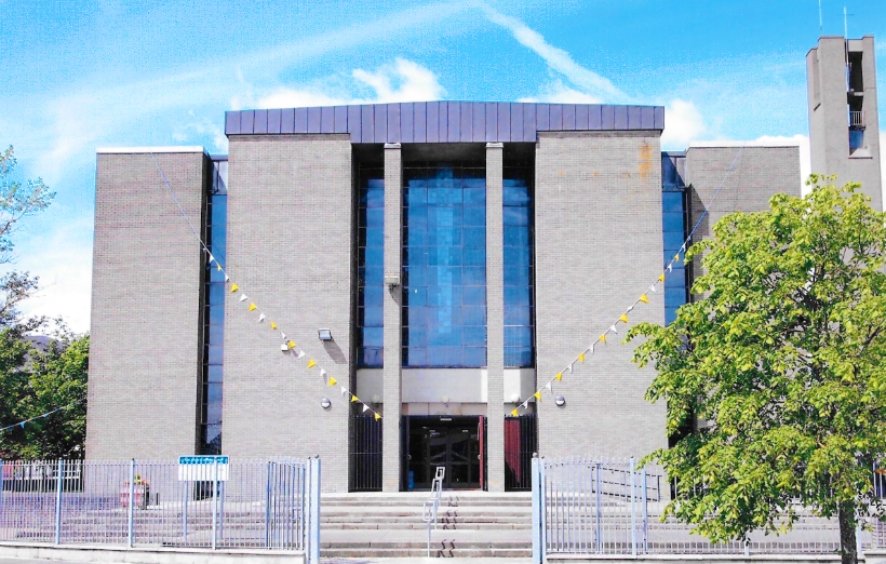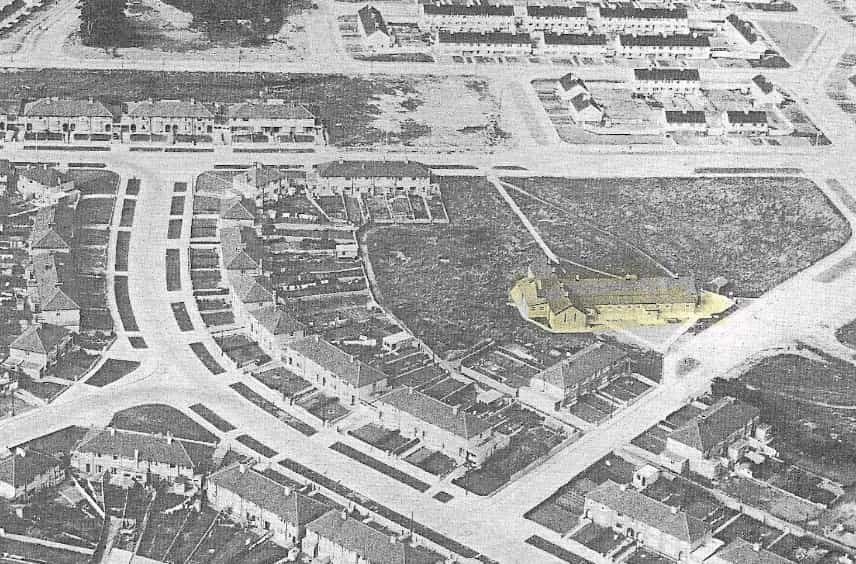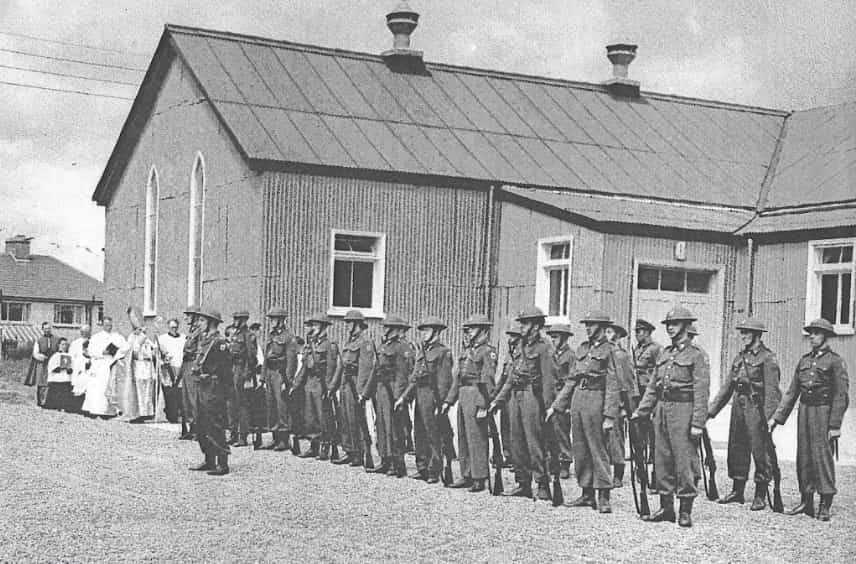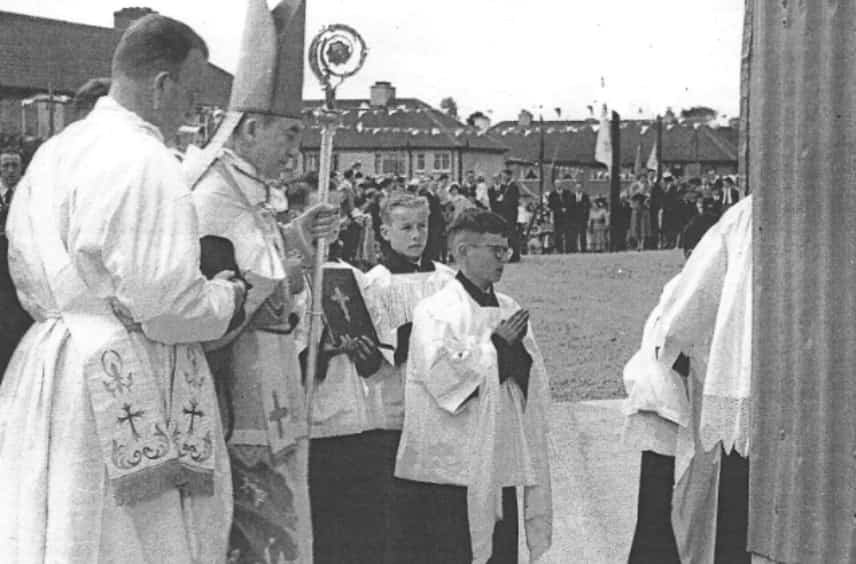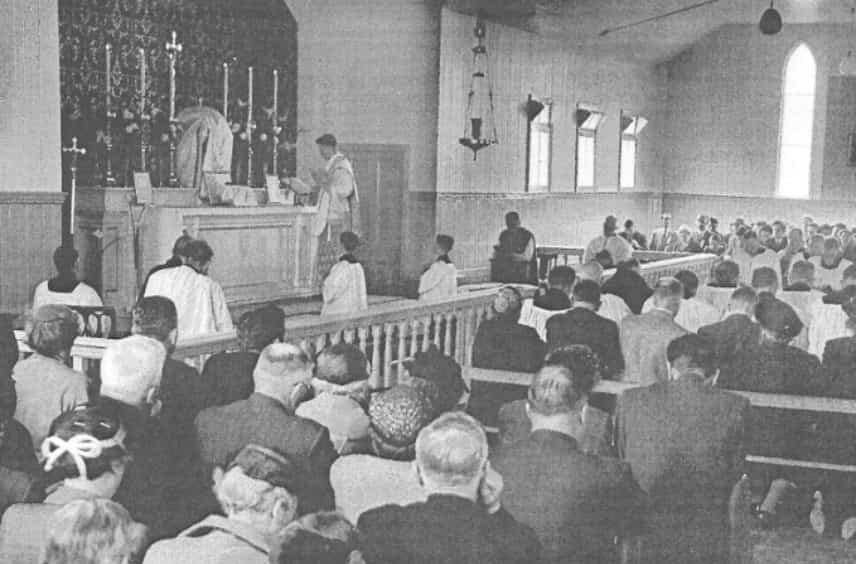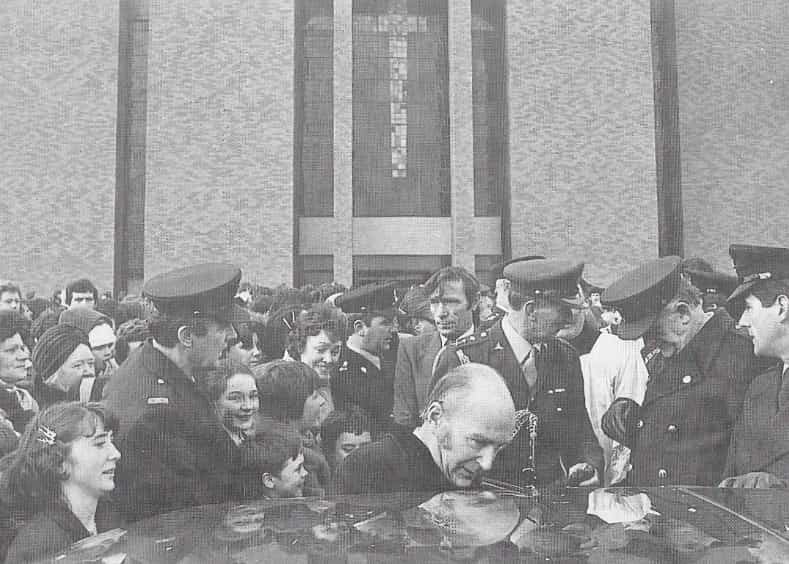Our Parish
Artane Parish History
In the late 1940's from Howth Road to Killester to the main Malahide Road Artane was an expanse of nurseries of bedding plants; dandelion and daisy dotted green meadows and sparsely placed heather-covered rocks. Serene and silent it lay - then as if an Archangel with feathery dove-like wings spread those wings over the scene - life entered the garden in the shape of red bricks; limestone; sand and cement. Woolly hatted men in designer turned down galoshes swayed like tight rope walkers on 2ft. planks with barrows of cement mix, bricks and wood, as they whistled and joked and worked well into the night to finish the houses that would make Artane into a living vibrant community.
The building boom was in progress; unemployment was a dirty word; everyone seemed to be entering a more prosperous phase of their lives and we were all convinced that was the way it was going to remain. Hope hovered in the air like a bright silvery cloud. We were alive; we had ambition; we were part of the new generation that was going to bring about a new Ireland and a new world.
There was no church building in Artane at that time. Coolock housed the parish church and it incorporated Raheny, Coolock and Artane. Monsignor Fitzpatrick was the parish priest and he resided in Killester. Father Corridan, now retired and living in Sandford, was senior curate in St. Brendan of Kerry, The Navigator, Church in Coolock and he was given the task of seeing to the new arrivals at Artane. He welcomed each family and blessed the houses. The people still talk of how delighted they were with his friendly personal greetings. They also speak of how hard he worked to establish Artane as a parish. So that people in Artane could attend Sunday Mass he arranged with C.I.E. for special Mass buses to be laid on every Sunday at 10.30 in Coolock and at 12.30 in Donnycarney. The more fit among the residents walked a couple of miles to attend Killester Church, while the more daring risked life and limb, muck and the frightening experience of a watching beady eyed rat, not to mention prosecution by the farmer - and crossed the farmland and railway lines which has now been transformed into the two railway bridges for the Dart. at Harmonstown and the one leading to the bungalows flat complex and houses at the Howth Road end of Brookwood Avenue to reach St. Brigid's church, Killester. The love for the Mass was very strong then.
The need for a church for the districts of Coolock, Artane and Ardlea which was blossoming into life at that time, became very evident and fund raising seemed to be the only solution as direct giving would not meet the need. Ardlea and Killester became parishes and the parish of Coolock - Artane was founded in 1955. The 2.150 families were given the name of Coolock Parish with the temporary tin church acquired from Cabra West blessed by Archbishop McQuaid and dedicated to Our Lady of Mercy in July 1955 serving the families of Artane. Father Corridan asked each family to contribute £1 towards the seating in the tin church which most duly did, although £1 was a lot of money in those days.
Greenfields House on the Malahide Road near St. Brendan's old church was again the venue for most of the fund raising. Canice McGovern remembers the fun and the hassle connected with the organization. Joined by Maureen Bulger, Mrs. Begley, Susan Colgan, Maureen Flynn and Mayme Connolly the knitting and the sewing and the collecting of food stuffs went on. Later, when Coolock became a parish in its own right, Greenfields House became the property of Coolock. It was razed to the ground as it was in a bad state of repair and the land was sold and used for building purposes. The proceeds went towards building a new church for Coolock.
Mrs Kathleen Monks came as first sacristan to the little tin church. She was a very dedicated and willing worker and before she retired in 1979 she was presented with the Bene Merenti medal from Pope John Paul II. Father Corridan departed for work in Wicklow parish and Father Kellv was appointed in his place.
In 1956 Canon D.P. Gallagher was appointed as Parish Priest. Some parishioners found him aloof and distant but Canice McGovern found him to be a shy, kindly, man who was very generous to the poor of the parish.
The fund raising for a bigger church to accommodate the ever increasing population of 6,000 parishioners crowded into the little tin church for Sunday Mass, continued but it was not moving very fast so in 1965 the Planned Giving Campaign was established. There was a lot of controversy and anger generated about the proposed Campaign and the canvassers met with some opposition as they made their way from house to house. It seemed alien and too high powered American for some of the parishioners. It was not I must stress that the parishioners objected to giving contributions week by week or month by month to the building fund; it was the fact that they were asked to sign a pledge, however non-legal or non-binding it was, that every wage earner in the family should contribute. Also the fact that they were asked to disclose the family income angered a number of people. However, like all family squabbles or parish squabbles it was resolved in due course and on 27th October 1968 the new Church of our Lady of Mercy was officially opened for worship. The foundation having been laid in 1967 by Archbishop McQuaid.
The cost was £240,000 eventually. Paddy Kelly provided the pulpit while his wife Kathleen presented the lovely statue of St. Joseph. The wooden benches were presented by other parishioners among them Jerry Sex. The beautiful crucifix over the high altar was presented by the women of the Parish to Canon Gallagher on the occasion of his own Golden Jubilee to the priesthood.
In 1969 Canon Gallagher died and is buried in the old Clontarf Cemetery in his parent's grave. Father John English a native of New Inn, Co. Tipperary, moved from Clontarf to take his place and to complete the building programme already begun. The task was a heavy burden for him and he worried about the fact that while the interest on the loan for the church was being paid, there was very little going off the capital. He died in 1977 and the present incumbent Father - now Canon Carbery - took over as Parish Priest. Canon Carbery came from Dolphins Barn where he was curate for three and a half vears. Before that he spent a five vear spell in Chile where he went to help the Columban Fathers in a shanty town mission for a hundred thousand poor people at San Luisin in the City of Santiago with a population of three million. Since then our parish has advanced in age and wisdom. We have had our highs and our lows; our festivals and our tragedies; our disagreements and our re-unions as any normal parish would. Our highs have come in the weekend Parish Renewals: the retreats; the processions when we all walked as one. The lows came at the Stardust Disco tragedy, also when two members of our parish, Mr. Fay, McAuley Road and Maureen Shields, Rosemount Avenue were killed in the terrible bombing in Talbot Street, a few short months after Thomas Duffy of Gracefield Avenue had been killed by the bomb that was placed in Sackville Place. There were also quite a number of our young people killed in tragic accidents over the years. We have had our Summer Projects, festivals when the Lord Mayor of Artane was crowned for the year and bonny baby competitions.
Now a great number of us have reached our Golden Years and we are still active and alive with our bowling; swimming; singing and dancing. We still have that spirit of hope we brought with us when we came here in the early fifties. Let us seek to give some of that spirit of hope along with the faith we share to the young people of our parish, so that Ireland may no longer have the despair and apathy that blighted her in the eighties.
The Planning Campaign which has given us this church of Our Lady of Mercy could not have operated without the time, patience and effort given to it by the Canvass Members: also the Lady Hostesses who arranged the 'Dinner' for same. Some now gone to their reward! The men 66 in number and the women 86 in number are too long a list to print here. They know who they are and I'm sure they are not looking for any praise now. Nevertheless we thank them for the work they did to provide us with the lovely church we have today. It will stand as a memorial to them.
